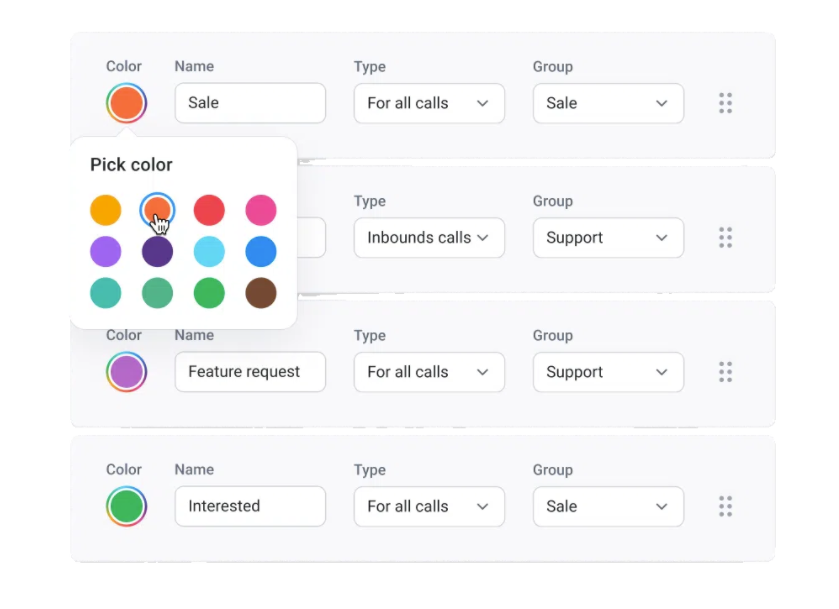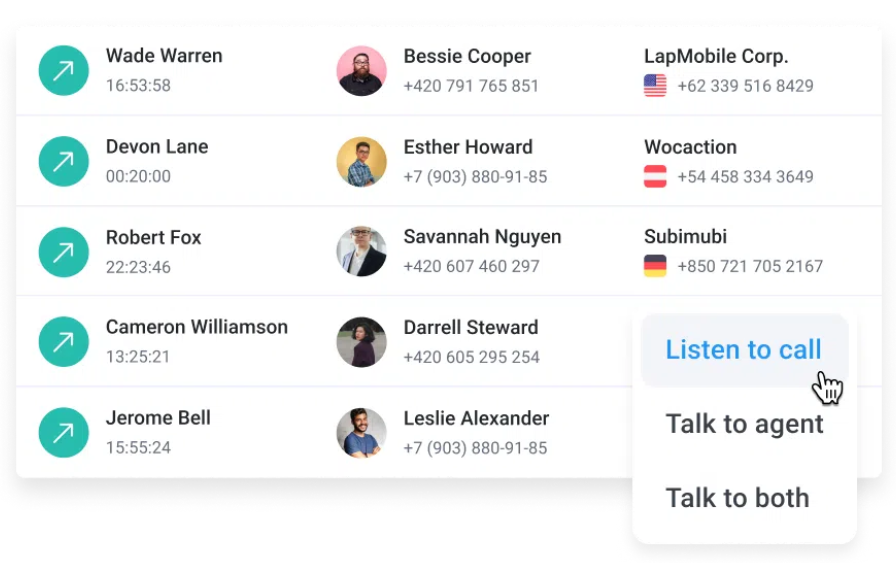A Guide to Creating Your Sales Workflow Process: 6 Steps and Best Practices

A Salesforce study found that companies with a playbook are 33% more likely to be high performers. This highlights the crucial role of a strong sales workflow in converting leads into loyal customers and driving sales success.
An effective sales workflow process lives and dies by its customer communication and workflow, whether through high-converting direct sales cold calling, great customer service, excellent team cooperation, or a mixture of all three.
But, pinpointing exactly how this sales workflow process should look, the stages it must include, and how to implement that process across your team in an easy, practical way, can be difficult. Ensuring it is highly effective — so you ramp up conversion rates and minimize lost leads — can be even tougher.
That’s why we’ve created this step-by-step guide. We’ve also outlined five best practices for your sales workflow process, so that you can build the best process for your business — and tweak it to conversion perfection.
Let’s get started.
Key takeaways:
- An effective sales workflow should be customer-focused, clearly defined, replicable, adaptable, and measurable. This approach helps in predicting revenue, improving processes, and streamlining onboarding and training.
- Sales automation is crucial for maintaining consistency and reducing human error in sales workflows.
- CloudTalk’s features, including call queuing, smart dialers, and automation tools, are instrumental in optimizing sales workflows.
Create a workflow to skyrocket sales. Use CloudTalk’s automation tools to implement revenue-boosting best practices.
What Is an Effective Sales Workflow?
First of all, let’s clarify what we’re talking about.
A typical sales workflow should fulfill the following five criteria:
- Customer-focused: Your sales process must be customer-centric and prioritize your target audience. Make sure your strategy centers on their needs and how your product or service benefits them.
- Defined: Each step of the process should be clear. Your sales team should be able to identify and distinguish each stage, and respond effectively.
- Replicable: Your sales process should be applicable to each new customer. This doesn’t mean the process must be identical for every type of prospect, but it must be repeatable again and again.
- Adaptable: Your sales workflow process must be able to adapt with each new lead and as your business strategy changes, or improves.
Measurable: They say you can’t manage what you can’t measure, and this is true of your sales workflow process. You need to be able to track your call center metrics so you can see what is successful, and what needs tweaking.
What Are The Benefits of an Effective Sales Workflow?

Beyond the obvious — that an effective sales workflow will boost revenue — it’s also worth making your sales workflow into a defined, measurable process with repeatable steps. This brings:
- More predictable revenue generation. Without a fully defined process, you can’t be sure what’s working, when, or how, so you can’t predict revenue with confidence. In contrast, a solid sales process helps to keep revenue more consistent, so you can predict it comfortably.
- Continued improvement. If you have a consistent process, you can measure what’s working and what isn’t. Not hitting a certain KPI? Look at your data, iterate, and improve. Repeat. What’s more, with as many as 40% of companies without a defined playbook, having one will give your company an extra competitive edge.
- Smoother onboarding and training. A defined sales workflow process makes it much easier to introduce and train new staff members in your methods, so you spend less time and money on training. It also enables staff to feel more welcome and become more experienced, better sales agents.
- Easier expansion. If you know what’s working, have predictable revenue, can save on recruitment and training, and have a repeatable process, you can roll out your process much more easily. You know where the money is coming from, and can rinse and repeat successfully.
Don’t just take our word for it: CloudTalk client Leadspicker improved its sales workflow dramatically with streamlined sales processes and call center automation tools, reducing the duration of its sales cycle by an incredible 92% (down to a few days, from the previous 1-2 month average).
6 Steps To Build a Strong Sales Workflow Process

Here’s how to start building the most effective sales workflow process for your business.
#1 Define Your Sales Stages
Just as we said above, an effective sales process needs to have clear, defined steps. And while each business will have different specifics, your stages must still include:
- Lead generation. Generating and finding the lead or new prospect.
- Qualification. Qualifying leads; gauging whether the lead is the right fit for your service.
- Proposal. This stage is where the lead starts to become a possible buyer. It should include the presentation of your service, such as offering a demo.
- Closing. This is where you and the soon-to-be-buyer agree on terms that work for both of you, come to a sales agreement, and make the sale.
Sales and call center software like CloudTalk can make each stage easier; for example, by storing customer details securely, showing Call History, and Call Tagging prospects throughout the customer journey. Plus, you can assign prospects markers such as VIP Status so they can skip the queue when it really matters.
Automation tools like Smart Dialer can help speed up the sales process too, which is crucial. A study found that following up with a web lead within five minutes of their sign-up makes them nine times more likely to convert…and a Lead Response study found this drops significantly after the first 30 minutes.
#2 Identify Key Activities for Each Stage
Each sales strategy stage should also include clearly-defined, key activities that must be completed at each stage, and successfully move the lead through the sales funnel.
For example:
- At the lead qualification stage: At these early stages, research the new lead, get clearer on their pain points and customer needs. Ask follow-up questions to check whether they are right for your service, are a decision-maker, and could become a client or buyer.
- At the proposal stage: This could include outreach, such as sending the lead a service proposal, free demo, or inviting them to book their own introductory call. You might also address objections, and give the lead a chance to ask any questions. This will likely include writing answers to common questions or stumbling blocks, and deciding on your approach if a lead has a particular issue.
- Post-closing: Once a lead has become a buyer, you will need to outline the next steps, and give your salespeople a roadmap for continuing to nurture the relationship. This might include sending beneficial follow-ups, scheduling regular phone calls, upselling, or communicating further offers later.
#3 Assign Responsibilities
A clear, effective process should also assign clear responsibilities and boundaries for your sales professionals at each stage.
This ensures each team member can work confidently and authoritatively within the stage they’re in. Plus, they don’t have to worry about if they’re stepping on another team member’s toes, or needlessly repeating or extending parts of the process.
It also means that your sales reps can work effectively, funneling the lead through the process at the exact right time, every time. This will also make the process more satisfying and seamless for the customers, improving your chances of closing deals.
Calling tools such as Call Queing and Preferred Agent — which CloudTalk offers — enable you to route sales calls directly to the correct team member depending on previous interacitions with agents, technical skills, or business needs.
This means they always speak to the right person who can help them most.
#4 Set Milestones and Deadlines
A repeatable process necessarily requires milestones at each stage, so your sales representatives can see where the lead is at any given time. That’s needed to move the lead along, and understand whether the approach is successful or not.
Milestones also need deadlines, to maintain momentum and prevent the lead from becoming disinterested and lost. The deadline schedule should be consistent and repeatable to ensure steady movement of the lead through the funnel toward conversion — and the post-sales nurturing sequence.
CloudTalk’s Group Reporting Tool is just one feature that enables sales managers to gain a bird’s-eye view of their team’s performance and current workflows, which can help determine deadlines and progress on milestones.
#5 Use Automation Tools
At this next stage of the sales process, it’s crucial to ensure the repeatability of your workflow with minimal error and maximum consistency. Enter automation.
Sales automation tools can significantly reduce any guesswork, risk of human error, and repetition, and save serious time on these perhaps more mundane aspects of the process.
This saves your team hours (making them more efficient and productive), and also frees them up to be more innovative, creative, and energized for the parts of the process that cannot be automated. For example, building human connection and flexibility of approach where needed.
CloudTalk’s features excel at implementing automation to make your teams and sales more effective, and save time.
For example, the Topics Extraction feature automatically pulls key topics from phone conversations, so it’s easy to adjust sales scripts based on real customer needs. And the Automatic Callback tool ensures any missed or unanswered calls get distributed across agents evenly.
This save agents considerable headaches in reaching a customer: A study found it can take up to eight calls to reach a prospect nowadays (more than the four or so it took in 2007).
#6 Measure and Analyze Performance
How will you know if your workflow is effective if you don’t measure it? (Spoiler: You won’t). At this stage, you need to set clear key performance indicators (KPIs) and track the available data. This lets you know if you’re on the right track or need to course-correct.
Needing to change track doesn’t mean your process is failing; in fact, continually re-evaluating your process and tweaking it to make consistent improvements and data-driven decisions is a solid part of a successful strategy.
All good calling platforms will enable you to track KPIs and other important metrics. For example, CloudTalk’s call center analytics software offers in-depth insights into call statistics, so you can boost agent outcomes and improve call center performance.
The Wallboard and real-time dashboard even show live performance metrics for instant visibility over how business is going at any given moment.
5 Best Practices for Your Sales Workflow Process

Now you have your sales workflow clearly outlined and ready to go, here are some best practices to turn a good process into a great one.
Implement a Customer-Centric Approach
‘Customer-focused’ is the first point included in the ‘What is a sales workflow?’ section above for a reason: It’s so crucial when implementing an effective process, as it ensures prospects have a seamless, excellent customer experience — with minimal friction.
Less friction equals less frustration. Happier leads are much more likely to convert.
That’s why you want to look out for features such as CloudTalk’s calling tools, designed to make managing and pleasing customers as streamlined as possible.
Here are three CloudTalk features that can help you put the customer first:
- 3-Way Calling tool lets colleagues jump in to help with complex issues with no delay
- Call Transfers make it easy for you to transfer a client if they need more in-depth assistance
- Talk/Listen Ratio tool ensures that customers are always being given priority.
Be Consistent
Consistency is the cousin of repeatability. It enables your workflow to be replicable, so you can track KPIs, iterate, and improve.
Luckily, one way to improve consistency is not only to systematize and define your processes (as we’re doing here!), it’s also to automate as many processes as possible — for example, by using tools such as CloudTalk’s Workflow Automation.
So you save time, reduce the risk of human error, and make your work more consistent. Win, win.
Over-Communicate
Just because each stage has clear boundaries and responsibilities within the team, this should not be confused with working in silos. Team members should consistently communicate with each other to ensure that each stage is successfully completed and ready to be handed over.
This is even more true if teams are remote. There is almost no such thing as over-communicating between remote teams; it’s always better to be courteous and check rather than wrongly assume.
This helps team cooperation, means everyone shares the same goal — and ensures a seamless, high-quality result for the client.
If you’re using CloudTalk, use these features to help you overcommunicate:
- Call Transfers to seamlessly redirect calls to the appropriate team member, ensuring customers quickly reach the right person
- Call Tagging to categorize and label calls for easy tracking and analysis, allowing for better organization and follow-up
- Customer Details features help your coworkers get up to speed easily
These features improve the smoothness of the reps’ response to the customer and fosters a sense of collaboration and cooperation between teams and agents.
Offer Training and Development
A well-trained team is an effective team, and an effective team is likely motivated, creative, hitting KPIs, and bringing in revenue. That’s why optimizing your workflow process should include constant training for your staff, which continues and goes far beyond the onboarding stage.
This enables your team members to feel that they’re part of the wider company mission, and keeps them updated and inspired with new sales techniques and the latest tools.
Sadly, research by sales training consultancy The Brevet Group found more than half (55%) of people working in sales “don’t have the right skills to be successful”. Proper training could significantly improve this, pushing up staff engagement, abilities, and company results.
Because you have recourse to automation, you can ‘outsource’ tedious jobs to technology, leaving your experienced staff members to hone the creativity and sales expertise only they can bring.
Try CloudTalk’s dedicated staff development tools:
- Agent Reporting for detailed performance metrics for individual agents, helping identify strengths and areas for improvement
- Group Reporting offers insights into team performance, enabling managers to assess overall efficiency and collaboration.
- Sentiment Analysis analyzes customer interactions to gauge emotional tone, allowing for better understanding of customer satisfaction and agent effectiveness.
Because as MHI Global states in its 2022 report: “The growth of each member of the group is positioned as the source of sustained development of the group.”
Review Regularly
The last step in ensuring an effective sales workflow is to regularly review it, and gauge how well it’s working. This will likely include call center monitoring of the latest data and checking up on KPI progress, but also iterating on your approach overall.
Using automation, data tracking and monitoring, and keeping your process as consistent as possible will let you identify and isolate any bottlenecks or areas for improvement. Iterate accordingly, and tweak elements one at a time, so you can see what’s making the most difference in your approach.
For example, harnessing the power of CloudTalk’s Analytics tool to collect call statistics and agent performance trends means you’ll now have the insights you need at your fingertips to make data-driven decisions that will genuinely move the needle forward.
This is key because a study by MHI Global found that 96% of world-class sales teams felt their management was held highly accountable for continuous improvement (compared to just 43% of ‘average sales teams’). So, to be “world-class”, aim for continuous improvement.
An Effective Sales Workflow: The Secret to Business Success
It’s clear: An effective sales workflow is one of the keys to high revenue and strong sales performance.
An effective process is customer-focused, well-defined, replicable, adaptable and measurable, so you can track KPIs and other metrics. You can expect everything from higher revenue and happier potential customers to more skilled sales reps and a shorter time between a new lead and closing the sale.
If you define your sales stages, identify key activities for each stage, and harness the power of automation, to name a few, you’ll be on the way toward building a highly effective sales workflow.
But to really excel, you’ll want to implement best practices such as ensuring your workflow is customer-centric and consistent.
Offering training and development to your sales team, fostering a culture of useful, over-communication; and staying committed to regular re-evaluation and improvement will take your workflow to new heights of effectiveness.
And using the full range of sales and call center suite tools by CloudTalk can make it even easier to implement and automate a strong sales workflow, for even better results.
Join the ranks of world-class sales teams. Automate repetitive tasks to let your staff shine with CloudTalk.
FAQs
What are some sales workflow examples?
Sales workflow examples will differ depending on the company and its needs. However, most effective sales workflow processes will have some combination of the following stages: Lead generation, qualification, proposal, closing, and follow-up.
How do you build a strong sales workflow process?
A strong sales workflow ‘construction’ process begins with you defining your sales stages, identifying key activities for each stage, assigning clear responsibilities for your team at each stage, setting milestones and deadlines, using automation tools to simplify tasks and save time, measuring and analyzing performance, and iterating new approaches to consistently implement improvements.
What are some best practices for the sales workflow process?
Best practices for the sales workflow process will take your workflow from good to great. They include ensuring your process is customer-centric and consistent. Next, foster good communication (even ”over-communication” between sales teams, and offer regular training and improvement. Lastly, always be reviewing, re-evaluating, and tweaking, so you can make impactful, data-driven decisions.
























